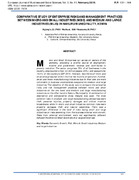COMPARATIVE STUDY OF ENTERPRISE RISKS AND MANAGEMENT PRACTICES BETWEEN MICRO AND SMALL INDUSTRIES (MSIS) AND MEDIUM AND LARGE INDUSTRIES (MLIS) IN NAKURU MUNICIPALITY, KENYA
Abstract
Micro and Small Enterprises cut across all sectors of the economy, providing a prolific source of employment, income and government revenue and contributes to
poverty reduction. The sector comprises 75% of all businesses in the country, employs more than 4.6 million people (30%) and accounts for
18.4% of the country’s GDP 2014. However, two-thirds of micro and small enterprises fail within the first few months of operation. Further, small and micro manufacturing industries due to their size are more vulnerable to business uncertainties compared to medium and large industries. The objective of this study was to compare the enterprise risks, and risk management practices between micro and small industries on the one hand and medium and large manufacturing industries on the other hand in Nakuru Municipality. A combination of descriptive and comparative study designs was used. The most common risks in medium and large manufacturing enterprises were theft, personal injuries, property damages and critical machine breakdowns while in micro and small industries common risks were property damages, theft and natural calamities. There was a significant difference in the level of risks facing small and large industries on risks stemming from the business internal environment. Risks from external environment were not significantly different between the Micro & Small and medium & large enterprises.
